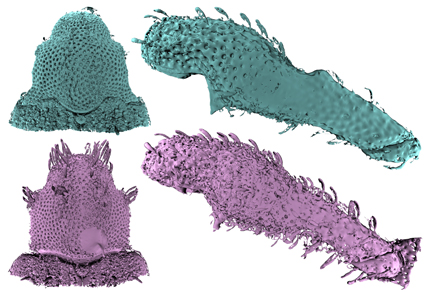Abstract
Karekizo Morimoto, 1962 represents a rarely collected, mountain-dwelling genus which has hitherto been known only from one species, K. impressicollis Morimoto, 1962, in Japan. Here, a second species, Karekizo depressus sp. n., is described based on a single specimen collected from Fen-Chi-Hu, Chiayi Hsien, Taiwan. The type species, K. impressicollis, is reported for the first time outside of Japan, from South Korea (Jeju Island, Mt. Hallasan). X-ray microtomography is used to non-destructively compare the sub-scale cuticular structure (e.g., density of punctures, presence of tubercles or carinae) of the two species. A photographic key to the species is also presented.
References
- Alonso-Zarazaga, M.A., Barrios, H., Borovec, R., Bouchard, P., Caldara, R., Colonnelli, E., Gültekin, L., Hlavá, P., Korotyaev, B., Lyal, C.H.C., Machado, A., Meregalli, M., Pierotti, H., Ren, L., Sánchez-Ruiz, M., Sforzi, A., Silfverberg, H., Skuhrovec, J., Tryìzna, M., Velázquez de Castro, A.J. & Yunakov, N.N. (2017) Cooperative Catalougue of Palearctic Coleoptera Curculionoidea. Monografías electrónicas SEA 8. Sociedad Entomológica Aragonesa S.E.A, Zaragoza, 729 pp.
- Cignoni, P., Callieri, M., Corsini, M., Dellepiane, M., Ganovelli, F. & Rangzuglia, G. (2008) MeshLab: an open-source mesh processing tool. Sixth Eurographics Italian Chapter Conference, Salerno, Italy, pp. 129–136.
- Fedorov, A., Beichel, R., Kalpathy-Cramer, J., Finet, J., Fillion-Robin, J-C., Pujol, S., Bauer, S., Jennings, D., Fennessy, F.M., Sonka, M., Buatti, J., Aylward, S.R., Miller, J.V., Pieper, S. & Kikinis, R. (2012) 3D Slicer as an image computing platform for the quantitative imaging network. Magnetic Resonance Imaging, 30 (9), 1323–1341.
- Hita-Garcia, F., Lieberman, Z., Audisio, T.L., Liu, C. & Economo, E. (2019) Revision of the Highly Specialized Ant Genus Discothyrea (Hymenoptera: Formicidae) in the Afrotropics with X-Ray Microtomography and 3D Cybertaxonomy. Insect Systematics and Diversity, 3 (6), 1–84. https://doi.org/10.1093/isd/ixz015
- Hong, K.-J., Park, S. & Han, K. (2011) Insect Fauna of Korea Vol. 12. No. 2. Arthropoda: Insecta: Coleoptera: Curculionidae: Bagoninae, Baridinae, Ceutorhynchinae, Conoderinae, Cryptorhynchinae, Molytinae, Orobitidinae—Weevils I. National Institute of Biological Resources Ministry of Environment, Incheon, 301 pp.
- Kojima, H. & Morimoto, K. (2004) An online checklist and database of the Japanese weevils (Insecta: Coleoptera: Curculionoidea) (excepting Scolytidae and Platypodidae). Available from: http://de05.digitalasia.chubu.ac.jp/index.html (accessed 3 October 2022)
- Lewis, J.H. (2023) A new species of Acicnemis Fairmaire, 1849 (Coleoptera: Curculionidae) from Okinawa and Ishigaki Islands, Okinawa Prefecture, Japan. The Coleopterists Bulletin. [in press]
- Morimoto, K. (1965) Descriptions of a new subfamily, new genera and species of the family Curculionidae of Japan (Comparative morphology, phylogeny and systematics of the superfamily Curculionoidea of Japan II). Journal of the Faculty of Agriculture, Kyushu University, 11 (4), 375–409. https://doi.org/10.5109/22691
- Morimoto, K. & Miyakawa, S. (1995). The Family Curculionidae of Japan. VIII. Subfamily Acicnemidinae. Esakia, 35, 17–62.
- Nadein, K. & Betz, O. (2018). Jumping mechanisms and performance in beetles. II. Weevils (Coleoptera: Curculionidae: Rhamphini). Arthropod Structure & Development, 47 (2), 131–143. https://doi.org/10.1016/j.asd.2018.02.006
- Shorthouse, D.P. (2010) SimpleMappr, an online tool to produce publication-quality point maps. Available from: https://www.simplemappr.net (accessed 1 December 2022)
- Soriano, C., Pollock, D., Néraudeau, D., Nel, A. & Tafforeau, P. (2013) First Fossil Record of Polypore Fungus Beetles from Lower Cretaceous Amber of France. Acta Palaeontologica, 59 (4), 941–946. https://doi.org/10.4202/app.2012.0074

